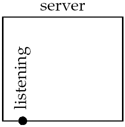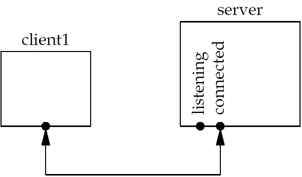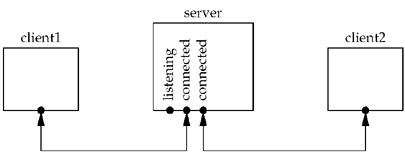6.8 TCP Echo Server (Revisited)
We can revisit our TCP echo server from
Sections 5.2 and
5.3 and rewrite the
server as a single process that uses select to handle any
number of clients, instead of forking one child per
client. Before showing the code, let's look at the data structures
that we will use to keep track of the clients. Figure 6.14 shows the state of the server
before the first client has established a connection.

The server has a single listening descriptor,
which we show as a bullet.
The server maintains only a read descriptor set,
which we show in Figure
6.15. We assume that the server is started in the foreground,
so descriptors 0, 1, and 2 are set to standard input, output, and
error. Therefore, the first available descriptor for the listening
socket is 3. We also show an array of integers named
client that contains the connected socket descriptor for
each client. All elements in this array are initialized to 鈥?.

The only nonzero entry in the descriptor set is
the entry for the listening sockets and the first argument to
select will be 4.
When the first client establishes a connection
with our server, the listening descriptor becomes readable and our
server calls accept. The new connected descriptor returned
by accept will be 4, given the assumptions of this
example. Figure 6.16 shows
the connection from the client to the server.

From this point on, our server must remember the
new connected socket in its client array, and the
connected socket must be added to the descriptor set. These updated
data structures are shown in Figure 6.17.

Sometime later a second client establishes a
connection and we have the scenario shown in Figure 6.18.

The new connected socket (which we assume is 5)
must be remembered, giving the data structures shown in Figure 6.19.

Next, we assume the first client terminates its
connection. The client TCP sends a FIN, which makes descriptor 4 in
the server readable. When our server reads this connected socket,
read returns 0. We then close this socket and update our
data structures accordingly. The value of client [0] is
set to 鈥? and descriptor 4 in the descriptor set is set to 0. This
is shown in Figure 6.20.
Notice that the value of maxfd does not change.

In summary, as clients arrive, we record their
connected socket descriptor in the first available entry in the
client array (i.e., the first entry with a value of 鈥?).
We must also add the connected socket to the read descriptor set.
The variable maxi is the highest index in the
client array that is currently in use and the variable
maxfd (plus one) is the current value of the first
argument to select. The only limit on the number of
clients that this server can handle is the minimum of the two
values FD_SETSIZE and the maximum number of descriptors
allowed for this process by the kernel (which we talked about at
the end of Section 6.3).
Figure
6.21 shows the first half of this version of the server.
Figure 6.21 TCP
server using a single process and select:
initialization.
tcpcliserv/tcpservselect01.c
1 #include "unp.h"
2 int
3 main(int argc, char **argv)
4 {
5 int i, maxi, maxfd, listenfd, connfd, sockfd;
6 int nready, client[FD_SETSIZE];
7 ssize_t n;
8 fd_set rset, allset;
9 char buf[MAXLINE];
10 socklen_t clilen;
11 struct sockaddr_in cliaddr, servaddr;
12 listenfd = Socket(AF_INET, SOCK_STREAM, 0);
13 bzero(&servaddr, sizeof(servaddr));
14 servaddr.sin_family = AF_INET;
15 servaddr.sin_addr.s_addr = htonl(INADDR_ANY);
16 servaddr.sin_port = htons(SERV_PORT);
17 Bind(listenfd, (SA *) &servaddr, sizeof(servaddr));
18 Listen(listenfd, LISTENQ);
19 maxfd = listenfd; /* initialize */
20 maxi = -1; /* index into client[] array */
21 for (i = 0; i < FD_SETSIZE; i++)
22 client[i] = -1; /* -1 indicates available entry */
23 FD_ZERO(&allset);
24 FD_SET(listenfd, &allset);
Create listening socket and initialize
for select
12鈥?4
The steps to create the listening socket are the same as seen
earlier: socket, bind, and listen. We
initialize our data structures assuming that the only descriptor
that we will select on initially is the listening
socket.
The last half of the function is shown in
Figure 6.22
Figure 6.22 TCP
server using a single process and select loop.
tcpcliserv/tcpservselect01.c
25 for ( ; ; ) {
26 rset = allset; /* structure assignment */
27 nready = Select(maxfd + 1, &rset, NULL, NULL, NULL);
28 if (FD_ISSET(listenfd, &rset)) { /* new client connection */
29 clilen = sizeof(cliaddr);
30 connfd = Accept(listenfd, (SA *) &cliaddr, &clilen);
31 for (i = 0; i < FD_SETSIZE; i++)
32 if (client[i] < 0) {
33 client[i] = connfd; /* save descriptor */
34 break;
35 }
36 if (i == FD_SETSIZE)
37 err_quit("too many clients");
38 FD_SET(connfd, &allset); /* add new descriptor to set */
39 if (connfd > maxfd)
40 maxfd = connfd; /* for select */
41 if (i > maxi)
42 maxi = i; /* max index in client[] array */
43 if (--nready <= 0)
44 continue; /* no more readable descriptors */
45 }
46 for (i = 0; i <= maxi; i++) { /* check all clients for data */
47 if ( (sockfd = client[i]) < 0)
48 continue;
49 if (FD_ISSET(sockfd, &rset)) {
50 if ( (n = Read(sockfd, buf, MAXLINE)) == 0) {
51 /* connection closed by client */
52 Close(sockfd);
53 FD_CLR(sockfd, &allset);
54 client[i] = -1;
55 } else
56 Writen(sockfd, buf, n);
57 if (--nready <= 0)
58 break; /* no more readable descriptors */
59 }
60 }
61 }
62 }
Block in select
26鈥?7
select waits for something to happen: either the
establishment of a new client connection or the arrival of data, a
FIN, or an RST on an existing connection.
accept new connections
28鈥?5
If the listening socket is readable, a new connection has been
established. We call accept and update our data structures
accordingly. We use the first unused entry in the client
array to record the connected socket. The number of ready
descriptors is decremented, and if it is 0, we can avoid the next
for loop. This lets us use the return value from
select to avoid checking descriptors that are not
ready.
Check existing connections
46鈥?0
A test is made for each existing client connection as to whether or
not its descriptor is in the descriptor set returned by
select. If so, a line is read from the client and echoed
back to the client. If the client closes the connection,
read returns 0 and we update our data structures
accordingly.
We never decrement the value of maxi,
but we could check for this possibility each time a client closes
its connection.
This server is more complicated than the one
shown in Figures 5.2 and
5.3, but it avoids all
the overhead of creating a new process for each client and it is a
nice example of select. Nevertheless, in Section
16.6, we will describe a problem with this server that is
easily fixed by making the listening socket nonblocking and then
checking for, and ignoring, a few errors from accept.
Denial-of-Service Attacks
Unfortunately, there is a problem with the
server that we just showed. Consider what happens if a malicious
client connects to the server, sends one byte of data (other than a
newline), and then goes to sleep. The server will call
read, which will read the single byte of data from the
client and then block in the next call to read, waiting
for more data from this client. The server is then blocked ("hung"
may be a better term) by this one client and will not service any
other clients (either new client connections or existing clients'
data) until the malicious client either sends a newline or
terminates.
The basic concept here is that when a server is
handling multiple clients, the server can never block in a function call related to a
single client. Doing so can hang the server and deny service to all
other clients. This is called a denial-of-service attack. It does something to
the server that prevents it from servicing other legitimate
clients. Possible solutions are to: (i) use nonblocking I/O
(Chapter
16), (ii) have each client serviced by a separate thread of
control (e.g., either spawn a process or a thread to service each
client), or (iii) place a timeout on the I/O operations (Section
14.2).
|